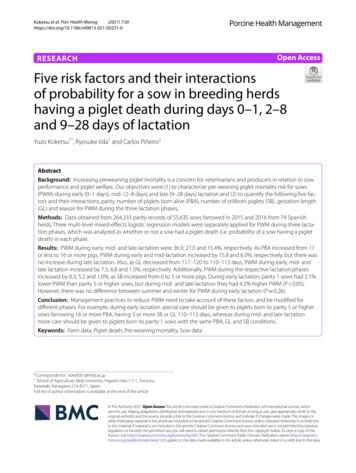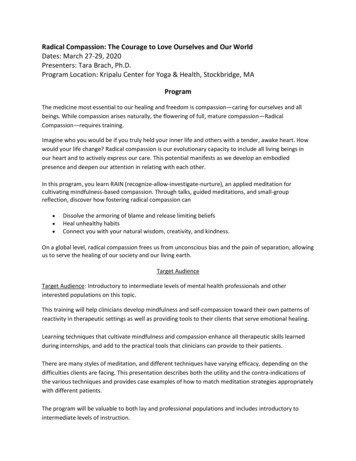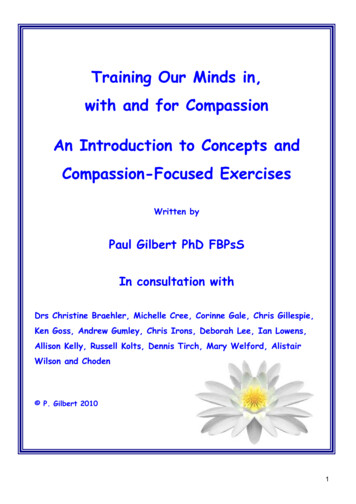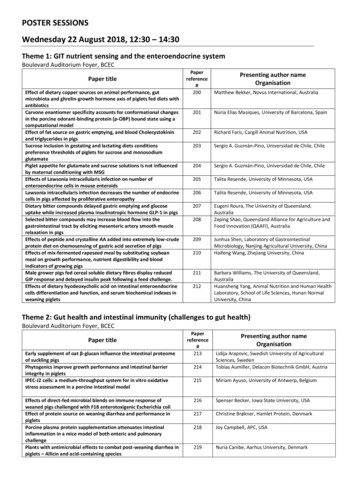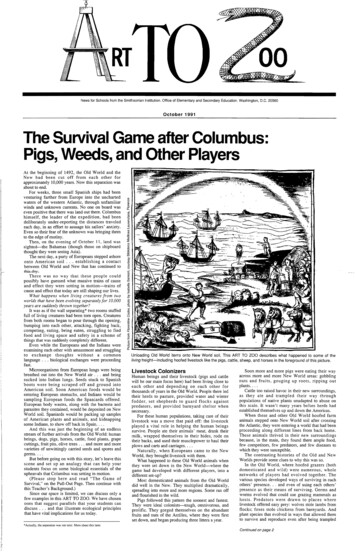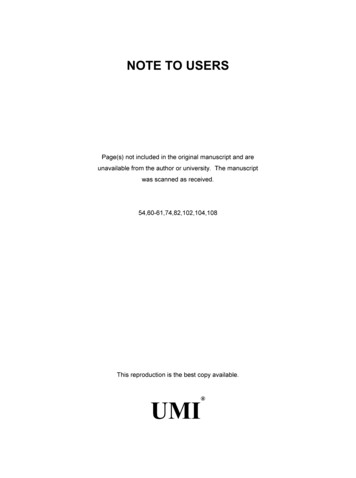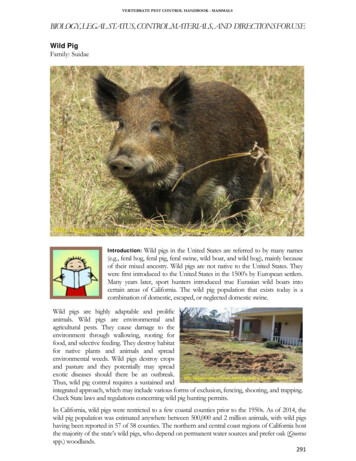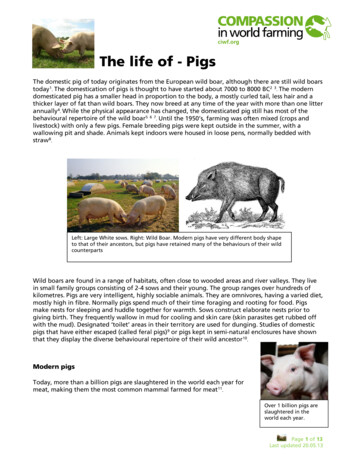
Transcription
The life of - PigsThe domestic pig of today originates from the European wild boar, although there are still wild boarstoday 1. The domestication of pigs is thought to have started about 7000 to 8000 BC 2 3. The moderndomesticated pig has a smaller head in proportion to the body, a mostly curled tail, less hair and athicker layer of fat than wild boars. They now breed at any time of the year with more than one litterannually 4. While the physical appearance has changed, the domesticated pig still has most of thebehavioural repertoire of the wild boar5 6 7. Until the 1950’s, farming was often mixed (crops andlivestock) with only a few pigs. Female breeding pigs were kept outside in the summer, with awallowing pit and shade. Animals kept indoors were housed in loose pens, normally bedded withstraw 8.Left: Large White sows. Right: Wild Boar. Modern pigs have very different body shapeto that of their ancestors, but pigs have retained many of the behaviours of their wildcounterpartsWild boars are found in a range of habitats, often close to wooded areas and river valleys. They livein small family groups consisting of 2-4 sows and their young. The group ranges over hundreds ofkilometres. Pigs are very intelligent, highly sociable animals. They are omnivores, having a varied diet,mostly high in fibre. Normally pigs spend much of their time foraging and rooting for food. Pigsmake nests for sleeping and huddle together for warmth. Sows construct elaborate nests prior togiving birth. They frequently wallow in mud for cooling and skin care (skin parasites get rubbed offwith the mud). Designated ‘toilet’ areas in their territory are used for dunging. Studies of domesticpigs that have either escaped (called feral pigs)9 or pigs kept in semi-natural enclosures have shownthat they display the diverse behavioural repertoire of their wild ancestor10.Modern pigsToday, more than a billion pigs are slaughtered in the world each year formeat, making them the most common mammal farmed for meat11.Over 1 billion pigs areslaughtered in theworld each year.Page 1 of 13Last updated 20.05.13
HousingThroughout the world, over half of commercial pig farming is highly intensive 12. This takes placeindoors and is also known as industrial pig production or ‘factory’ farming. Adult female pigs arekept in close confinement systems throughout their lives. Their offspring are kept in barren pens athigh stocking densities (expressed as the available floor area per animal), until they are ready to gofor slaughter.Several alternatives to intensive farming systems have been developed to overcome welfare concernsassociated with intensive farming. Most are based on traditional farming systems that werecommonly in use before industrialisation took place in the 1950s. Some use modern technology toachieve better welfare.Breeding and rearing animalsThere are a number of different types of pig kept in farming systems. The animals used for breedinginclude:1.2.3.4.1. Gilts: young adult female pigs that have not yet produced a litter of piglets (called farrowing)Sows: adult female pigs that have farrowed one or more litters.2. Dry sows: adult female pigs from weaning (separation from piglets) until farrowing. They arecalled ‘dry’ because they are not producing milk to suckle piglets.3. Farrowing sows: adult female pigs from farrowing until weaning.4. Boars: adult male pigs used for mating with sows and gilts.The animals reared for meat include:1.2.3.4.Piglets: pigs from birth until weaning (at 2-4 weeks).1. Weaners: pigs from weaning until the age of 10 weeks.2. & 4. Rearing pigs: pigs from 10 weeks until slaughter age at about 6 months.3. Growers or growing pigs: pigs in the early stage of rearing.4. Fatteners or finishing pigs: pigs in the latter stage of rearing.Page 2 of 13Last updated 20.05.13
Intensive and alternative pig farmingPigs are kept in a variety of farming systems:IntensiveBreeding animals are kept indoors in close confinement systems throughout their lives. Rearinganimals are kept indoors in groups in barren pens, at high stocking densities. Temperature andventilation in the buildings has to be closely controlled as the animals are unable to easily maintainbody temperature by using pig-specific behaviour such as wallowing in mud.Semi-intensiveBoth breeding and rearing animals are kept indoors in pens at high stocking densities with little orno access to bedding or litter. Farrowing sows are usually confined in crates.Enriched indoorsBreeding animals and rearing animals are both kept indoors in spacious deep-bedded barns. Thebedding may be straw, wood shavings or other material, which is replenished as needed. Farrowingsows are not confined.OutdoorsBreeding animals are kept in outdoor paddocks. Rearing animals have access to outdoor areas. Mostorganic pig farming is outdoors.ExtensiveIn some parts of the world, notably Spain, Sweden and Brazil, pigs are allowed to roam freely insemi-natural enclosures.Intensive pig farmingEnriched indoor pig farmingOutdoor (extensive) pig farmingIntensive pig farmingMost pigs used in intensive systems are based on a crossing of two breeds (Large White x Landrace).The breeding animals have been selected to maximise the number of piglets they can produce in ayear. On average, modern sows have 10 piglets per litter and have 2.4 litters per year13 but some arehaving 13 or 14 piglets per litter. At the end of the production period - after they have had anaverage of 3-5 litters - sows are culled (brought to slaughter)14, aged about 1½ to 2 years. The meatanimals have been selected to have large appetites, rapid growth rates and good food conversionratios (meaning how much of their food is converted into body weight, such as muscle and fat).Modern pigs can reach a slaughter weight of 100 kg in 24 weeks 15.Page 3 of 13Last updated 20.05.13
SowsAt breeding time, dry sows and gilts are introduced into a small penthat contains a single boar, who then mates with them (‘serving’). Thismay be repeated if they do not become pregnant. Pigs are examinedwith ultrasound to confirm pregnancy, about one month after mating.Artificial insemination (AI) can also be used whereby boar semen isintroduced manually into the sow by the stockperson (caretakers). Oncemated, both gilts and dry sows are kept in either ‘sow stalls’ or ‘tetherstalls’ (see below) during their pregnancy which lasts for about 114days (3 months, 3 weeks and 3 days). Stalls are used to maximise thenumber of animals that can be housed in a given area. Stalls alsoprevent the sows from fighting each other and make it easier tomanage the sows (e.g. provide veterinary treatment) with fewerstockmen.Sow stall – used for pregnantsows throughout their gestationperiod. A few days before theyare due to give birth, they aremoved to a farrowing crate.Sow stallsA narrow steel cage that completely surrounds the sow and does not allow for a lot of movement orturning around. Stalls have concrete floors with usually a slatted area at the rear through which dungcan pass or the floors are fully slatted. Stalls are banned in the EU 16, except for the first 4 weeks andthen the last week of pregnancy, when the sow is moved to a farrowing crate (see below).Tether stallsSimilar to stalls but the sow is fixed in position by using atether or belt tied around her neck or girth. Tether stalls areless common than free stalls and banned in the EU.Stalls have troughs at the front for the provision of food andwater. Sows are fed a concentrated diet based on cereals. Theration is designed to maintain the sow’s body weight andgrowth of her unborn piglets; the quantity of food given maybe reduced during late pregnancy to reduce the risk ofobesity. This can lead to hunger.Tether stalls where sows are kept duringtheir pregnancy, and tethered with achain or strapBoarsBoars are generally kept singly in pens. This is partly toprevent aggression and partly to ensure paternity ofoffspring (so that the farmer knows who has fathereda litter). The pens are usually also used for mating.Bedding is often provided to ensure good foothold forthe boar during mating. On some farms boars are keptin pens with slatted floors and in some countries theyare kept in sow stalls and only removed for mating.Boars may have their tusks trimmed 17 to preventinjuries to stockpersons and other pigs. It isrecommended that this procedure is carried out by aBoars are normally penned alone.vet using an orthopaedic saw once the boar has beensedated. However, the procedure is often carried outby the stockperson using bolt cutters without the use of sedatives or painkillers. This can leave thetrimmed tusks exposed to infection.Page 4 of 13Last updated 20.05.13
Farrowing sowsAt 3-7 days prior to giving birth, sows are moved to farrowingcrates. Like sow stalls, farrowing crates consist of a steel cagethat completely surrounds the sow, not allowing her to walkmore than a couple of steps or turn around. The bare concretefloors usually have a slatted area at the rear for dunging or thecrates are fully slatted. In some systems, litter material such aswood shavings may be provided to reduce the risk of the sowslipping and crushing her piglets. Heated creep areas (hideareas) are usually provided for the piglets and these encouragethe piglets to lie away from the sow, this prevents pigletcrushing (see below).Farrowing crates are used for sowsabout to give birth and until weaning.Farrowing crates were designed to restrict the sow’s movement and reduce the risk of heraccidentally crushing her piglets, as this is not only a welfare issue, but also an economic one for thefarmer. Modern sows have been bred to have much larger litters than their wild boar relatives. As aresult, the piglets tend to be much smaller and weaker at birth and therefore more prone toaccidental crushing. Modern sows are much larger than their wild cousins and the size ratio betweenthe mother and piglets is almost 100:1, further compounding the risk of piglet crushing.Farrowing crates can lower costs, by limiting the amount of building space required and bysimplifying management of sows. Any supervision or veterinary treatment to the sow or her pigletscan be safely and readily given.After giving birth, the sow remains with her piglets in the farrowing crates until they are weaned(removed), at 2-4 weeks. Most intensive farms practice ‘cross-fostering’ where piglets from largelitters are removed and placed with sows that have smaller litters. In some systems, the sow andpiglets may only be kept in the farrowing crate for the first few days when the risk of crushing isgreatest. The farrowing crate may then be opened up to form a pen. Alternatively, they may bemoved to individual pens or group suckling pens where a number of sows and their piglets can suckletogether. After weaning, sows are returned for mating or AI to repeat the reproduction cycle or theyare sent away for slaughter (‘culled’).PigletsWithin a few days after birth, piglets are given a series of vaccinations. A number of mutilations arecarried out without any sedation or pain relief, including:Pigs with docked tails no longer have their curlytail. Tails are commonly docked in barrensystems to prevent wounds from pig’s bitingeach other’s tails.Tail dockingTail docking involves the removal of up to two thirdsof a piglet’s tail with a hot blade or sharp pliers 18.This is to try and reduce the incidence of tail-bitinglater in life, as this can lead to pigs being culledbefore they reach slaughter age. It is also a welfareproblem for pigs that have been tail bitten, as theirtail scan bleed and become infected. The EU PigDirective does not allow the routine tail-docking ofpigs and pig farmers need permission from a vet todo so 19.Page 5 of 13Last updated 20.05.13
Teeth clipping/grindingThe piglets’ sharp corner teeth are removed down to the gums by clipping them with sharp pliers orthe tip of these teeth is removed with special grinders. Teeth clipping/grinding is performed toreduce the risk of suckling piglets causing damage to both each other while fighting for the sow’steats, or damage to the sow’s udder. The EU Pig Directive does not allow the routine teeth clippingof pigs and pig farmers need permission from a vet to do so 20.CastrationIn some countries, male piglets are castrated by removing their testeswith a scalpel or sharp knife. This is to ease handling and reduce ‘boartaint’ which in sexually mature animals can leave an unpleasant taste inthe meat. Immuno-castration is now permitted in the EU, this involvesinjections with a vaccine against male hormones and prevents thedevelopment of the testes 21.Nose ringingNose ringing involves the insertion of metal rings into the nose to reducerooting activity that can cause environmental damage in outdoor adultpigs 22.A sharp blade (and nopain sedation) is used tocastrate piglets whenthey are only a few daysold.Ear notchingEar notching involves cutting several notches around the tip of each ear using notching pliers. Thepurpose is the permanent identification of pigs used mainly for breeding.Ear notching involves cutting several notches around the tip ofeach ear using pliers. The purpose is permanent identificationof pigsWeaner pigsPiglets are separated from their mothers at an age of 3-4 weeks(weaning). In the US, weaning can be done as early as 1-2 weeks. Byremoving piglets early, the sow can be mated again and early weaningtherefore maximises the number of piglets a sow can have in a year.Natural weaning would not occur until the piglets were over 12 weeksof age. EU rules prevent weaning before 28 days for most pig-rearingsystems, except in “all-in, all-out” units where the limit is 21 days23.After weaning, the piglets are transferred to so-called ‘flat deck’ pens,which are often barren and have slatted or part-slatted flooring. Thepiglets are mixed into groups with different litters (this should bedone as young as possible, preferably before or up to one week afterweaning in order to prevent excessive fighting 24. The pens containThese piglets have had theirtails docked to reduce the riskof tail biting in the barrenenvironment. Rather thanenriching the environmentthey have mutilated thepiglets.Page 6 of 13Last updated 20.05.13
feeders and drinkers and often include heated areas or heating lamps.Rearing pigsIn intensive farming, rearing pigs are housed indoors and grouped into pens. The pigs are reared athigh stocking densities with approximately 1m2 of floor area provided for each 100 kg pig. Highstocking densities are used to save on space and costs. The pen floors are usually fully slatted, someare part-slatted and others have solid concrete floors. Slatted floors allow urine and slurry (manure)to pass out of the pens into collecting tanks below. Straw bedding cannot be used because it wouldblock the openings in the floor and the slurry system below.The EU Pig Directive requires that all pigs must have permanent access to manipulable material toenable proper investigation and manipulation activities 25. Enrichment objects or well-designed pig‘toys’ can be provided, if pens have part-slatted floors. Bedding (straw or other materials such as sawdust or rice hulls peat, compost, and various wood chips26, has the highest potential to providesuccessful enrichment 27.In barren conditions, pigs can redirect their chewingbehaviours towards pen fittings and other pigs includingtheir tails and ears. Bitten tails can bleed and then attractother pigs so that the behaviour can quickly spreadthroughout the whole group. Pigs with bitten tails cansuffer pain and infection. Pig’s tails are docked to helplimit this (see above), but it can also be prevented byproviding an enriched environment that offers stimulation.During the growing phase, the pigs can be re-grouped intonew pens with unfamiliar pigs and this can lead to furtherThese rearing pigs are housed in pens withfully slatted floors without any enrichment,except for a single chain which is notsufficient enrichment.problems with aggression and tail-biting 28.Alternative pig farmingPigs can be kept in a range of alternative farmingsystems. Traditional breeds, such as Tamworth,Saddleback, Gloucester Oldspot, Pietrain, Iberian andMeishan, or their crosses, are often used in thesesystems. These breeds tend to have smaller litters of6-8 piglets and farrow only once or twice a year.Although they have fewer litters than modernbreeds, they usually have better mothering abilities.These pigs also take longer to reach slaughter weight(at 36 weeks of age), but the meat quality isperceived to be better. Modern breeds, such as theLarge White and the Duroc can also be reared in lessintensive systems. These breeds are bred throughoutthe year and will have larger litters similar to whenthey are kept in the more intensive systems.Higher welfare systems for pigs provide anenvironment that allows pigs to perform more of theirnatural behaviours.Page 7 of 13Last updated 20.05.13
SowsOn alternative pig farms, dry sows are kept in groups in either indoor housing or outdoor systems.Indoor housingDry sows are generally kept in spacious deep-bedded barns. When sows are mixed together afterweaning, unfamiliar sows will fight to establish a dominance order 29. Aggression is reduced byproviding more space, bedding material and barriers that allow weaker sows to escape behind.At feeding time, dominant sows may bully weaker sows to gain more food. Several feeding systemshave been developed to overcome this problem: Feeding stalls: allow sows to be locked up individually while beingfed, they are released afterwards.Electronic sow feeders: provide one feed station for each group ofsows that can be accessed by each sow in turn, using transpondersfitted around the sow’s neck 30.Scatter feeders: distribute the food over a large surface area so thatsows are more spaced out and can avoid each other while eating 31.Trickle-feed systems: release food slowly into an individual feedstation and the sows learn that it is not to their advantage to leave afeed station and muscle in on another32.A sow is entering an electronic feeder. The sowcan only enter with her individual transponderattached around her neck.Outdoor housingDry sows can be kept in groups in outdoor paddocks. Huts bedded with straw to provide shelter fromthe weather. In hot countries, shaded areas and wallows may also be provided to allow the sows tocool down. Concentrated feed is usually distributed using scatter feeders and water is provided introughs.BoarsOn good alternative farms, boars are kept singly in spacious deep-bedded pens. On some outdoorunits, ‘teams’ of 2-3 boars live together in paddocks with recently weaned sows.Farrowing sowsFarrowing cratesSome farms only use farrowing crates for the first few days post-farrowing when the risk of pigletsbeing crushed is highest. The crate may then be opened up into a pen or the sow and litter may bemoved out altogether. In Sweden, farrowing crates may only be used for a maximum of one week.Free farrowingThe ‘Swedish group system’ allows the farrowing sow freedom of movement at all times. Each sowhas her own box to farrow in but is able to leave her piglets and carry out normal activity. Althoughgood production figures have been attained, problems can arise with sows entering each other’sboxes leading to higher piglet mortality. In a natural environment, sows would normally seekseclusion at this time.Individual pens or ‘free farrowing systems’ (for example PIGSAFE 33) have been developed toovercome the problems with group systems, whilst meeting the sow’s preference for seclusion atPage 8 of 13Last updated 20.05.13
farrowing time. The better designs have plenty of deep-bedded straw and good piglet protectiondevices such as piglet escape areas and anti-crush bars 34. Management is also key to success35.Arks/huts: outdoor systems use individual farrowing ‘arks’ or huts that are deep-bedded with straw.Although there can be higher piglet mortality when the weather is extremely cold and wet, UKfigures show that outdoor systems can rear the same number of piglets as farrowing crates 36. Organicfarming 37 is based on outdoor farrowing systems.Free farrowing systems do not restrainthe sows during or after farrowing.Arks are used in outdoor systems andprovide shelter during adverseweather conditions.PigletsIn most alternative, higher welfare systems, piglet mutilations are not carried out. Teeth-clipping isnot usually necessary because outdoor breeds tend to have smaller litters with more robust/healthypiglets so there is less competition at the udder. Tail-docking is not necessary because the pigs areusually reared in spacious pens with deep bedding offering plenty of distractions and an outbreak oftail-biting is therefore less likely to occur. Mutilations are not routinely permitted under EU organicfarming 38. Castration of male piglets still occurs and some producers use pain killers during thisprocedure.The trend in the UK and many other countries has been to delay weaning. This is because it isbelieved that piglets are less susceptible to diseases such as Postweaning Multisystemic WastingSyndrome (PMWS) which causes illness in piglets 39. EU organic rules delay weaning till at least 40days 40. Some organic farm schemes in the EU require weaning no earlier than 8 weeks 41.Weaner pigsIn most alternative systems, weaners are kept in indoorpens. This is because they are less able to cope withenvironmental (weather) extremes. Even in organicfarming, weaners are generally kept indoors. Pens usuallyhave deep bedding. In different parts of the world,different substrates have successfully been used asbedding including straw, wood shaving, rice hulls andpeanut straw.Some systems provide indoor kennels with an outdoorrun. Weaners reared completely outdoors needWeaners in enriched indoor systems arehoused in pens with solid floors and bedding,allowing them to perform more naturalbehaviours like foraging and exploring.protection from extremes of weather and from predatorssuch as foxes and badgers.Deep-bedded kennels with draft excluders are used inPage 9 of 13Last updated 20.05.13
cold climates, shades and wallows in hot climates. Protection against predators is usually provided byelectric fencing.Rearing pigsRearing pigs are kept in a variety of different husbandry systems. Most rearing pigs tend to be keptindoors. This is because if they are kept outdoors on pasture, they will root it all up. Paddocks aresoon turned into giant mud baths. In some countries, the pig’s ability to clear the land has been putto good use. Farmers in the UK and Sweden have used pigs to ‘plough’ the land after harvest andalso clear woodland after it has been felled.Pigs in higher welfare systems have more spaceand enrichment, such as straw bedding.Indoor housingRearing pigs are usually kept in large groups in spaciousdeep-bedded barns or ‘hoop’ structures such as used inthe USA 42. The type of substrate used varies from countryto country depending on what is grown there. Theprovision of fibrous organic material allows pigs to carryout highly motivated foraging activities and preventstail-biting 43. This means that pigs in these alternativesystems are not tail-docked. Stocking densities tend tobe lower than in intensive systems. The quality andquantity of bedding and its ability to absorb the dung isimportant to keep the bedding clean. Alternative deepbedded systems can work out 50% cheaper to set upthan intensive systems 44. Pigs reared outdoors can alsoshow better growth rates and lower mortality thanthose kept in intensive systems 45.Outdoor housingMost outdoor farms have deep-bedded huts or kennels with an outer court or yard which has aconcrete base with further bedding on top. Many organic units are based on this type of system 46. Onorganic units, the space allocation from weaning to slaughter is 0.8-1.3 m2 per pig indoors, plus 0.61.0 per pig m2 outdoors. Another system is to provide mobile housing so that once the pigs havecleared the land, they can be moved on to another area. Various sheds and large tents with wallsconstructed from straw bales have been designed for this purpose. The pigs are usually enclosed withelectric fencing.Extensive farming systemsRearing pigs can be kept outdoors on pasture orwoodland as long as there is plenty of space and/orfrequent rotation. In Andalucia (Spain), the tradition ofkeeping Iberian pigs in extensive oak woodlands stillsurvives. The pigs forage on acorns and benefit fromliving in a near natural-habitat. However, males are stillcastrated and many have nose rings to discouragerooting.Extensive pig farming requires a lot of landto allow for rooting behaviour.Transport and slaughterAt the end of the rearing period the pigs are transported to slaughter. Modern farms providefacilities such as well-designed walk-ways and loading ramps to facilitate handling and loading ofpigs onto transporters. The majority of pigs are slaughtered for bacon at a live-weight of 90-110 kg,Page 10 of13Last updated 20.05.13
when the pigs are 20 to 24 weeks of age. In the UK and Ireland, pigs are not castrated so they tend tobe slaughtered at a lower weight to reduce the risk of boar taint flavour in the meat of adult boars.Pigs sold for pork are slaughtered at a live-weight of 55-60 kg.Pigs are slaughtered by being individually introduced into a restraining box where they are renderedunconscious by stunning them, usually with an electric current applied by electrodes or by gasstunning (using carbon dioxide or non-aversive gas mixtures, such as argon or nitrogen) 47. Sometimesa captive bolt device (a gun that shoots a metal pin into the brain) may be used. After stunning, pigsare bled out by cutting their throats. In some countries without welfare legislation, pigs may be killedwithout stunning.References1Ekesbo I. (2011). Farm Animal Behaviour: Characteristics for assessment of health and welfare. Swine (Sus scrofa). CAB InternationalWallingford UK. Pp.17-412Clutton-Brock J. (1999). A natural history of domesticated mammals. Cambridge University Press, Cambridge3Giuffra E., Kijas J.M.H., Amarger V., Carborg O ., Jeon J.-T., Andersson L. (2000). The origin of the domestic pig: independentdomestication and subsequent introgression. Genetics 154: 1785-17914Sisson (1975) in Ekesbo (2011), op. cit.5Stolba A., Wood-Gush, D.G.M. (1984). The identification of behavioural key features and their incorporation into a housing designfor pigs. Annales de Recherches Veterinaires 15: 287-2986Stolba A., Wood-Gush D.G.M. (1989). The behaviour of pigs in a semi-natural environment. Animal Production 48: 419-4257Jensen P. (1988). Maternal behaviour of free-ranging domestic pigs. I: Results of a three-year study. Swedish University ofAgricultural Sciences, Report 22 [in Swedish]8Ekesbo I. (2011), op. cit.9Kurz J.C., Marchinton R.L. (1972). Radiotelemetry studies of feral hogs in South Carolina. Journal of Wildlife Management 36: 124010Stolba, Wood-Gush (1984), op. cit.11FAO(2010) http://faostat.fao.org/site/339/default.aspx [Accessed 26 November 2012]12Ibid.13BPEX (2012). Pig Yearbook. British Pig Executive, Stoneleigh, UK14Ibid.15Ibid.16Council Directive 2008/120/EC laying down minimum standards for the protection of pigs. ri OJ:L:2009:047:0005:0013:EN:PDF17Robertson J.F., Arey D.S. (1998). Pig Husbandry Guide No.2 Teethcare. SAC Publication18Simonsen H.B., Klinken L., Bindseil E. (1991). Histopathology of intact and docked pigtails. British Veterinary Journal 147: 407-41119Council Directive 2008/120/EC, op. cit.Page 11 of13Last updated 20.05.13
20Council Directive 2008/120/EC, op. cit.21Fabréga E., Velarde A., Cros J., Gispert M., Suárez P., Tibau J., Soler J. (2010). Effect of vaccination against gonadotropin-releasinghormone, using Improvac, on growth performance, body composition, behaviour and acute phase proteins. Livestock Science 132: 535922Studnitz M., Jensen K.H., Jorgensen E. (2003). The effect of nose ringing on the exploratory behaviour of outdoor gilts exposed todifferent tests. Applied Animal Behaviour Science 84(1): 41‐5723Council Directive 2008/120/EC, op. cit.24Friend T.H., Knabe D.A., Tanksley Jr. T.D. (1983). Behavior and performance of pigs grouped by three different methods atweaning. Journal of Animal Science 57: 1406–141125Council Directive 2008/120/EC, op. cit.26Studnitz M., Jensen M.B., Pedersen L.J. (2007). Why do pigs root and in what will they root?: A review on the exploratory behaviourof pigs in relation to environmental enrichment. Applied Animal Behaviour Science 107(3–4): 183-19727Van de Weerd H.A., Day J.E.L. (2009). A review of environmental enrichment for pigs housed in intensive housing systems. AppliedAnimal Behaviour Science 116 (1): 1-2028Schrøder-Petersen D.L., Simonsen H.B. (2001). Tail biting in pigs. Veterinary Journal 162: 196-21029Arey D.S., Edwards S.A. (1998). Factors influencing aggression between sows after mixing and the consequences for welfare andproduction. Livestock Production Science 56: 61-7030Barnett J.L., Hemsworth P.H., Cronin G.M., Jongman E.C., Hutson G.D. (2001). A review of the welfare issues for sows and piglets inrelation to housing. Australian Journal of Agricultural Research 52(1): 1- 2831Hulbert L.E., McGlone J.J. (2006). Health and Well-Being: Evaluation of drop versus trickle-feeding systems for crated or grouppenned gestating sows. Journal of Animal Science 84: 1004-101432Leeb B., Leeb C., Troxler J., Schuh M. (2001). Skin lesions and callosities in group-housed pregnant sows: animal-related welfareindicators. Acta Agriculturae Scandinavica, Supplement 30: 82-8733Edwards S.A., Baxter E.M. (2010). The PigSAFE Project: Developing an alternative to the farrowing crate. Recommended dimensionsand details for building PigSAFE pens. November 2010.34Arey D.S. (1997). Behavioural observations of peri-parturient sows and the development o
The life of - Pigs . The domestic pig of today originates from the European wild boar , although there are still wild boars today. 1. The domestication of pigs is thought to have started about 7000 to 8000 BC. 2 3. The modern domesticated pig has a smaller head in proportion to the body, a mostly curled tail, less hair and a


